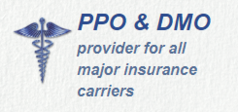
Root Planing & Scaling Therapy
In periodontal disease, bacteria causes damage to the gums and
teeth, making the "pockets” around the teeth deeper. Once the pockets
get to a certain depth, even with diligent home care by the patient, it
is difficult for a toothbrush and floss to reach the tartar and plaque
found on the surface of the teeth; the disease progresses without
treatment.
What is necessary to stop the progression of disease and promote
healing is the mechanical removal of the tartar from the roots of the
teeth by the the periodontist or hygienist. This procedure is called
Scaling and Root Planing. To keep the patient comfortable, the dental
professional may administer local anesthetic to the areas they are
working on. The deposit is removed from the tooth and root surfaces,
leaving the periodontium in the best position to heal.
An adjunctive treatment to non-surgical therapy is the use of
antibiotics. In periodontal disease, the antibiotic is applied directly
to the site of disease, meaning, in the periodontal pocket adjacent to
the tooth, in the form of an antibiotic strip or powder. Antibiotics can
also be administered in pill form.
Four to six weeks following the Scaling and Root Planing, we will
re-do a partial PSR (Periodontal Screening and Recording) to check the
depths of the pockets around the teeth. If the treatment was successful,
the pockets should have shown improvement by decreasing in depth, and
the tissues should appear healthier. If the treatment was unsuccessful, a
more aggressive, surgical form of treatment will be strongly
recommended. Sometimes, even in cases of advanced periodontal disease, a
non-surgical approach will be necessary before surgical therapy.



